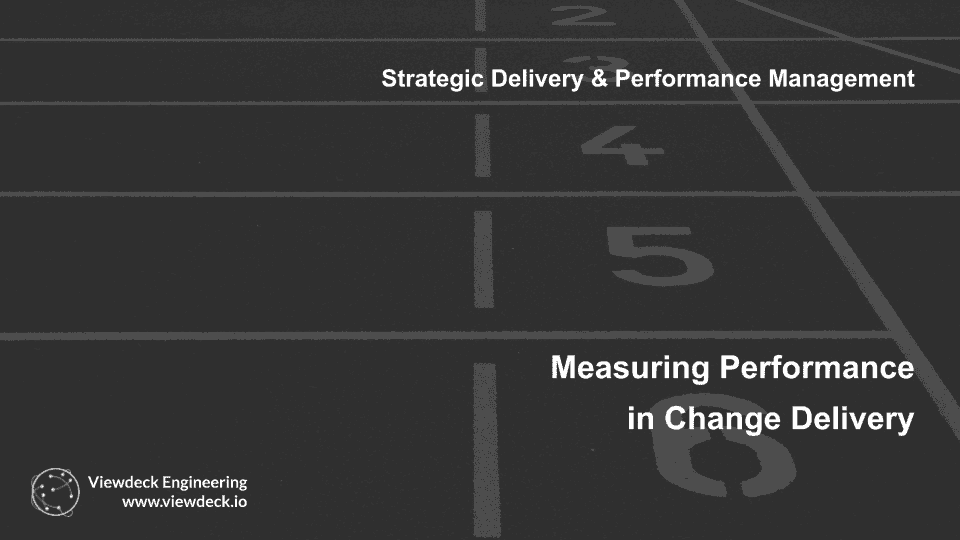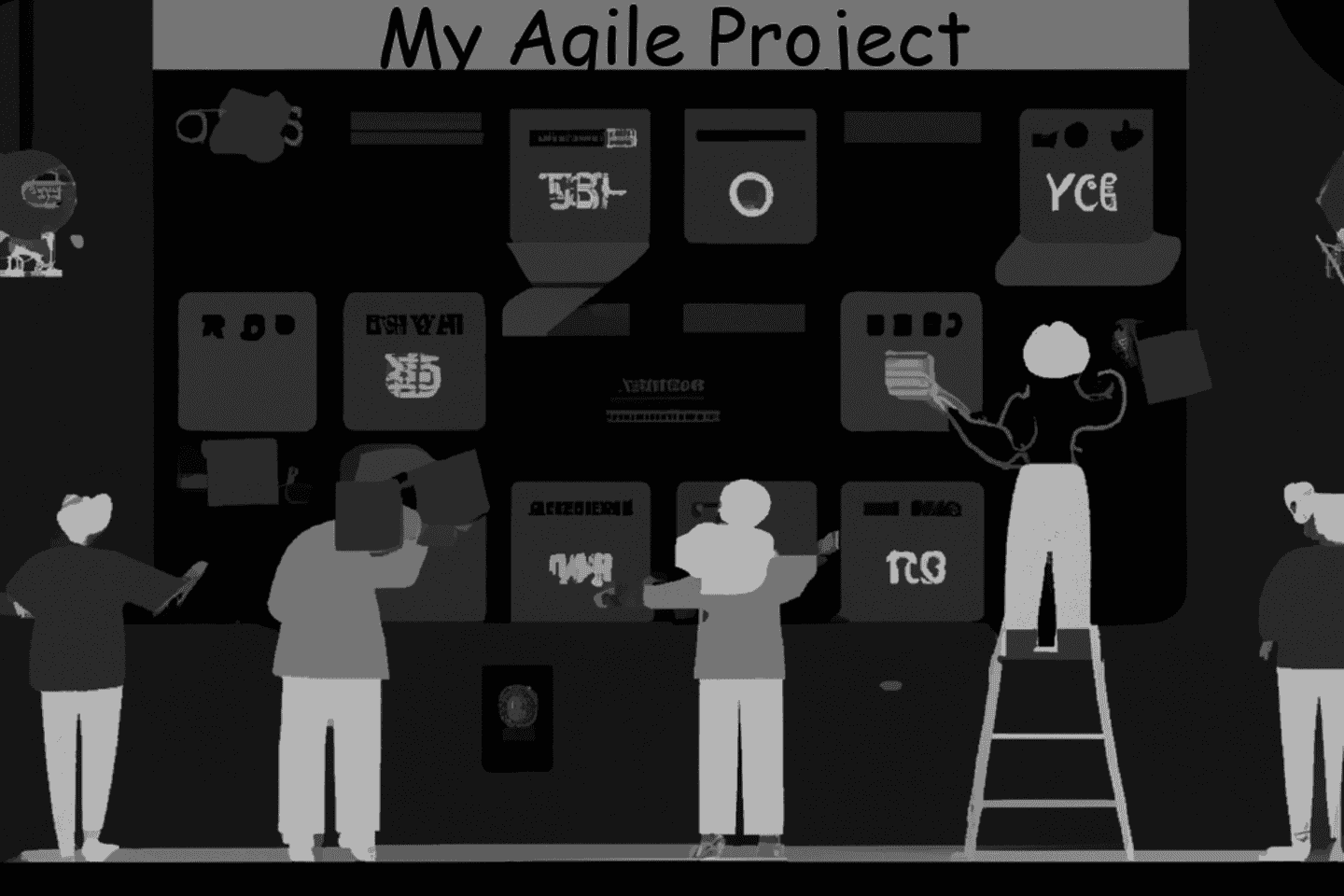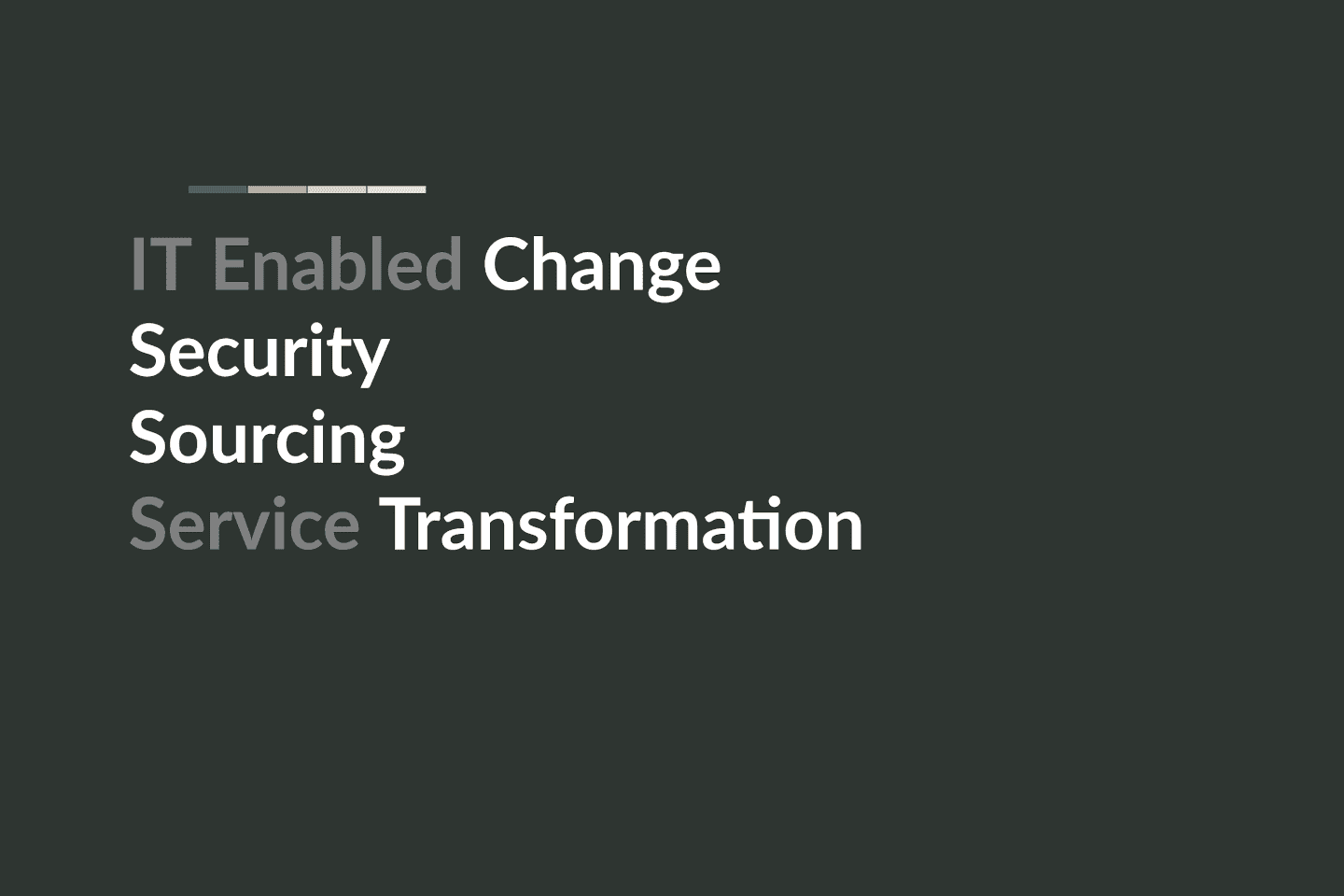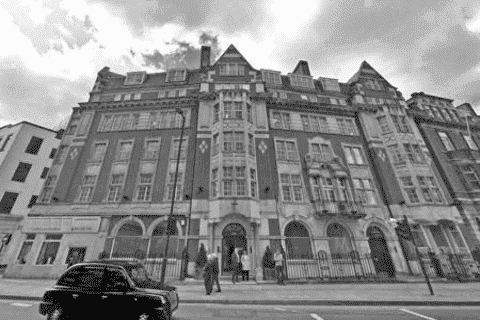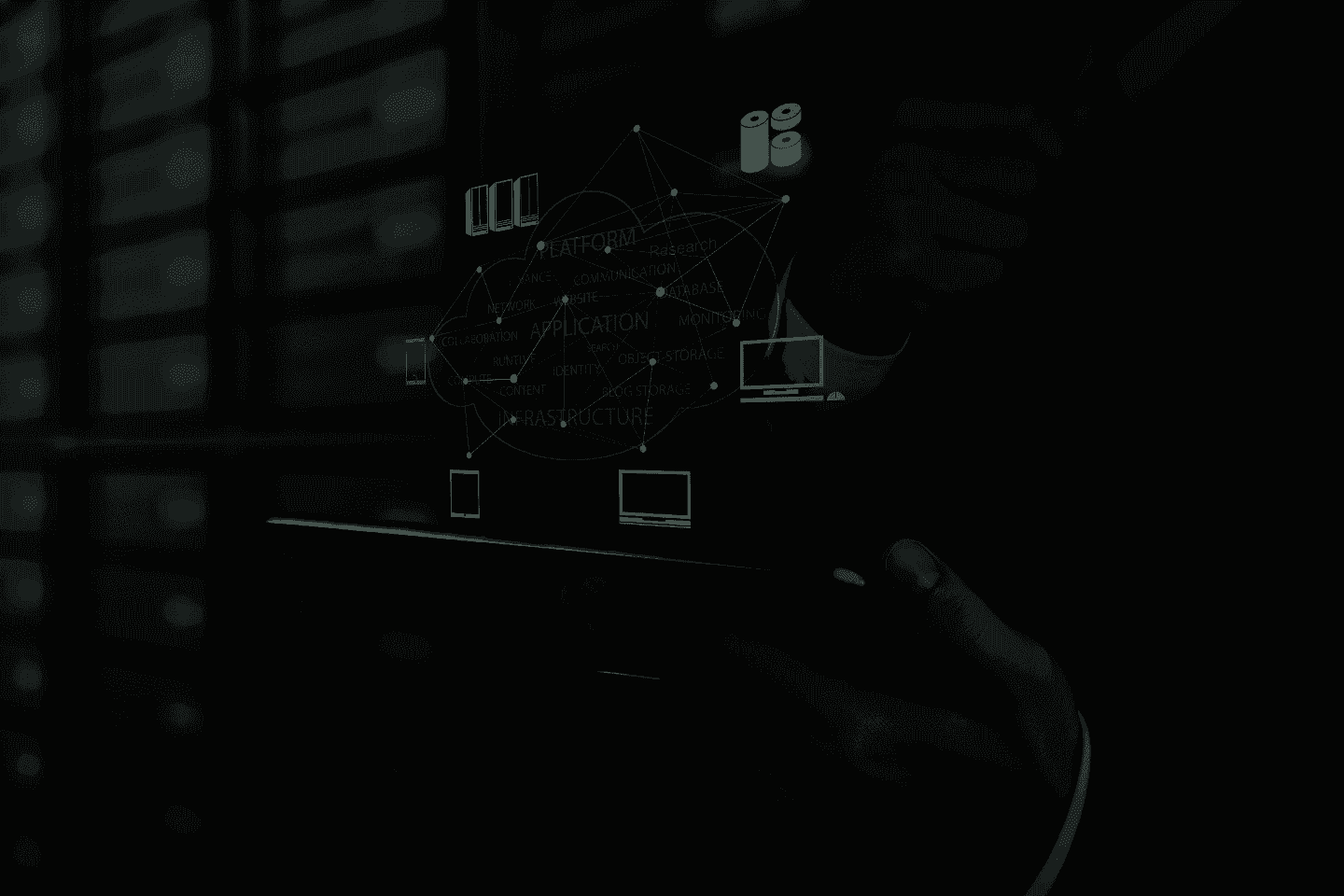Navigating Organisational Transformation: Capability Modelling
Take the journey from your current operational structures to your optimised and agile future world.
A Journey from As-Is to To-Be Capability Models
As we navigate the complex world of organisational development, one concept stands as a cornerstone for effective transformation - the capability model. Whether we're considering a military organisation, a public sector entity, or a critical national infrastructure agency, understanding our 'as-is' state is the launching pad for all future growth and change. This exploration takes us on a journey from the current operational landscape to the envisioned future, providing invaluable insights into how we can reshape our capabilities to align with our strategic objectives. So, let's unpack this process step-by-step, considering the unique challenges and opportunities each type of organisation might face. Welcome to this enlightening exploration of how to capture, evaluate, and evolve an organisation's capability model.
Capability Modelling - What is it ?
A capability model is a framework that describes the complete set of capabilities an organisation requires to execute its business strategy and fulfill its mission. It provides a structured view of an organisation’s abilities so that it can execute actions necessary for achieving its strategic goals and objectives.
Capabilities in this context are the abilities that an organisation has which are key to delivering value. For example, capabilities might include things like product development, customer relationship management, supply chain management, or IT management, among others.
A capability model typically includes the following elements:
- Capability Domains: These are high-level groupings of capabilities. For example, a company might have domains like 'Sales', 'Marketing', 'Operations', 'Finance', etc.
- Capabilities: Within each domain, there will be a number of individual capabilities. For example, within the 'Sales' domain, you might have capabilities like 'Account Management', 'Sales Forecasting', 'Product Demonstration', etc.
- Sub-Capabilities: Each capability can be broken down further into more specific abilities, often referred to as sub-capabilities.
- Capability Owners: For each capability and sub-capability, there should be a defined owner who is responsible for the performance and development of that capability.
- Capability Maturity: This measures how well developed a capability is within the organisation. It can range from 'Initial' (the capability is unstructured and ad hoc) to 'Optimised' (the capability is fully integrated and continuously improving).
A well-structured capability model provides a clear view of what the organisation needs to do to deliver on its strategy. It can be used to identify gaps and redundancies, prioritise investment, and align activities across the organisation. It is a critical tool for strategic planning, organisational design, and business transformation.
Measuring Capability Maturity
Capability maturity is the degree of formality and optimisation of a/the processes within an organisation, from ad hoc practices to formally defined steps to managed result metrics to active optimisation of the processes.
It's a measure of how well the capabilities of an organisation are developed and managed. This concept has been extensively developed in the software industry but applies to any organisation or system.
One widely accepted method of measuring capability maturity is the Capability Maturity Model Integration (CMMI), developed by the Software Engineering Institute (SEI) at Carnegie Mellon University. CMMI provides a framework for improving processes and describes the maturity of an organisation's capabilities based on five levels:
- Initial (Level 1): Processes are ad-hoc, chaotic, or even nonexistent. The organisation usually does not provide a stable environment and success depends on individual effort.
- Managed (Level 2): The projects of the organisation are managed in accordance with documented plans, processes, and procedures. The necessary process discipline is in place to repeat earlier successes.
- Defined (Level 3): The organisation's set of standard processes are established and improved over time. These standard processes are used to establish consistency across the organisation.
- Quantitatively Managed (Level 4): The organisation and projects establish quantitative objectives for quality and process performance and use them as criteria in managing processes.
- Optimizing (Level 5): Continual process improvement is enabled by quantitative feedback from the process and from piloting innovative ideas and technologies.
These levels are then used to benchmark and measure the maturity of the organisation's capabilities. However, not every capability needs to be at the highest level of maturity; the change programme in conjunction with the business strategy, should determine the appropriate level of maturity based on its business needs, and resources.
Developing the As-Is Capability Model
Capturing an "as-is" capability model for an organisation during operating model design involves understanding the current functional capabilities of the organisation, how these capabilities are executed, and how they support the organisational goals. The standard process to create an as-is capability model are:
1. Identify Core Capabilities
Begin by identifying the core capabilities of the organisation. These are the unique abilities that differentiate the company from its competitors, such as superior customer service, product innovation, or supply chain management. Involve different stakeholders, from leadership to front-line employees, to get a holistic view.
2.Document Current Processes
After identifying core capabilities, document the current processes that support these capabilities. This involves mapping out the activities, roles, and resources involved in each process. Process mapping can be a simple high-level overview or a detailed step-by-step flowchart, depending on the complexity of the organisation.
3. Determine Capability Owners
For each capability, identify the individual or team who is responsible for its execution. Understanding ownership can help clarify roles and responsibilities, and identify potential areas of confusion or conflict.
4. Assess Capability Performance
Evaluate the performance of each capability against relevant performance measures. This could be efficiency (how quickly a task is performed), effectiveness (how well a task is performed), or adaptability (how easily the process can adjust to changes).
5. Identify Interactions and Dependencies
Identify how different capabilities interact with and depend on each other. This will help you understand the organisation as a system, rather than a collection of isolated capabilities.
6. Identify Gaps and Opportunities
As you map out the as-is capability model, you're likely to identify gaps in capabilities or opportunities for improvement. These could be processes that are inefficient, roles that are unclear, or resources that are lacking.
7. Validate the Model
Once the as-is capability model is complete, validate it with stakeholders to ensure it accurately reflects the current state of the organisation. This validation process may reveal additional insights or corrections.
8. Document the Model
Finally, document the model in a form that can be easily understood and shared with stakeholders. This could be a diagram, a report, or a digital model. The key is to create a clear, visual representation of the organisation's current capabilities.
Remember, the as-is capability model is a starting point for designing the future operating model. It helps identify what's working well and what needs to be improved, providing a solid foundation for transformation.
Capability Modelling for Public Sector Organisations
While the basic steps for capturing an as-is capability model remain the same, there are nuances to consider when dealing with a public sector organisation or a central government department:
- Regulatory and Policy Compliance: Government entities have to comply with a variety of regulations and policies that may not apply to private sector organisations. These may shape the current capabilities in unique ways, and understanding these regulations is key to accurately capturing the as-is model.
- Public Accountability: Government departments are accountable to the public and often have a higher level of scrutiny on their activities. As a result, transparency and communication may be more important, and there might be more stakeholders involved in the process.
- Political Considerations: Government departments operate within a political context. This can influence decision-making, priorities, and resource allocation. The as-is capability model needs to take into account these political influences.
- Bureaucracy and Red Tape: Government departments often have bureaucratic processes that can make change more difficult. These processes might slow down the as-is capability modelling process, but they are part of the current operating model and need to be documented.
- Service Orientation: Government departments are often more service-oriented than profit-oriented. This could influence their core capabilities and the metrics used to measure performance. For example, instead of revenue or profit, a government department might measure success in terms of service delivery or public satisfaction.
- Budget Constraints: Public sector organisations often operate under tight budget constraints. These constraints can impact the organisation's capabilities and its ability to change or improve them.
- Stakeholder Management: In public sector, there are often multiple stakeholders with different, sometimes conflicting, interests. These include politicians, the general public, special interest groups, other government agencies, and more. Managing these interests is a key capability in itself.
- Inter-agency Coordination: Government departments often need to coordinate with other departments or agencies. Understanding these relationships is crucial for capturing the as-is capability model.
Remember, the goal of capturing the as-is capability model is the same: to understand the current functional capabilities of the organisation, how they are executed, and how they support the organisational goals. However, these factors can make the process more complex in a public sector context.
Capability Modelling for Defence Organisations.
While the basic principles of capturing an as-is capability model are the same, certain factors are unique to military organisations. These factors can influence the way you approach the process, and how it might differ:
- Classification and Security: Military organisations often deal with sensitive information that is classified for security reasons. This can limit who can participate in the process, and how information is shared and documented. There may be additional steps involved in ensuring that the process complies with security protocols.
- Hierarchy and Command Structure: Military organisations have a strict hierarchy and command structure that can influence the capability model. The decision-making process may be centralised, and there may be a clear chain of command for each capability. This can influence how capabilities are executed and who owns them.
- Resource Availability: Military organisations may have resources that are not typically found in other organisations, such as specialised equipment or personnel. Conversely, they may also face constraints that other organisations do not, such as limited budgets or personnel availability.
- Mission Focus: The core capabilities of a military organisation will likely be closely tied to its mission. This could include capabilities like intelligence gathering, combat operations, or peacekeeping. The mission focus can influence how capabilities are evaluated and prioritised.
- Training and Readiness: Military organisations place a high emphasis on training and readiness. This can influence how capabilities are evaluated, with a focus on how well the organisation can respond to different scenarios or threats.
- Interoperability: In military context, the capability to operate jointly with other military forces (allies or other branches of the military) is crucial. This will impact the way capabilities are assessed and how dependencies are identified.
- Physical Locations and Deployments: Military organisations often operate in multiple locations, or have to deploy to different environments. This can influence how capabilities are executed and the resources they require.
- Regulations and Standards: Military organisations often have strict regulations and standards that can influence how capabilities are executed. There may be additional steps involved in ensuring compliance.
The goal of capturing the as-is capability model is the same: to understand the current functional capabilities of the organisation, how these capabilities are executed, and how they support the organisational goals. However, these factors can make the process more complex in a military context.
Capability Modelling for Organisations supporting Critical National Infrastructure
When dealing with a public sector organisation that focuses on critical national infrastructure, law and order, security assurance, and defence of the nation, the process of capturing an as-is capability model would entail unique considerations:
- Security: Given the high-stakes nature of their work, these organisations often deal with highly classified and sensitive information. This can limit who can participate in the process, how information is shared, and how it is documented. Moreover, cyber-security would be a central capability to safeguard the nation's critical infrastructure.
- Interoperability and Coordination: These organisations often need to coordinate and operate jointly with other agencies, both domestically and internationally. This involves shared capabilities and necessitates robust communication and data-sharing processes.
- Crisis Response and Resilience: These organisations need to be prepared to respond to emergencies or crises effectively and quickly. This involves capabilities related to disaster management, resilience, and rapid response.
- Regulatory Compliance: These organisations need to comply with a variety of national security regulations and laws, which may shape their current capabilities in unique ways.
- Public Accountability and Transparency: Despite their security-focused roles, these organisations are still accountable to the public. Balancing transparency with security requirements is a unique challenge that may influence their capabilities.
- Political Context: Decisions made within these organisations are often influenced by the political climate, both domestic and international. This can impact priority-setting and resource allocation.
- Technology and Innovation: Given the nature of threats to national security, these organisations often have to stay on the cutting edge of technology and innovation. They need robust capabilities in research, technology adoption, and innovation.
- Training and Readiness: Like military organisations, these entities also place a high emphasis on training and readiness to respond to various scenarios, threats, or disasters.
- Risk Management: These organisations have to manage a wide array of risks, from physical threats to cyber-attacks. Risk management, therefore, becomes a critical capability.
Again, the basic principle of capturing an as-is capability model—understanding the organisation's current functional capabilities, how these are executed, and how they support the organisation's goals—remains the same. The unique factors associated with critical infrastructure, law and order, security assurance, and defence just add layers of complexity and nuance to the process.
How to Create the To-Be Capability Model for the Organisation
The process of taking an as-is capability model, evaluating it, and creating a to-be capability model that aligns with vision, goals, and objectives involves multiple stages. Here is a step-by-step guide:
1. Evaluate the As-Is Capability Model:
Review the as-is capability model, considering how effectively the current capabilities of the organisation are meeting its goals and objectives. This evaluation should take into account efficiency, effectiveness, and adaptability. Look for gaps, redundancies, inefficiencies, or opportunities for improvement.
2. Define Vision, Goals, and Objectives
Clearly articulate the future vision, goals, and objectives of the organisation. The vision is a broad statement of where the organisation wants to be in the future, while goals and objectives are more specific, measurable statements of what the organisation plans to achieve to realise that vision.
3. Identify Required Capabilities
Based on the vision, goals, and objectives, identify what capabilities the organisation will need in the future. Consider both functional capabilities (like sales or customer service) and cross-functional capabilities (like innovation or agility).
4. Gap Analysis
Compare the required capabilities with the current capabilities from the as-is model. This will help identify gaps that need to be filled and areas where current capabilities can be improved or scaled back. This gap analysis forms the basis for the to-be capability model.
5. Design the To-Be Capability Model
Create a model that illustrates the desired future capabilities of the organisation. This should show not just what the capabilities are, but also how they interact with each other, who owns them, and how they contribute to the organisation's vision, goals, and objectives.
6. Create an Implementation Plan
Based on the to-be capability model, create a detailed plan for how to transition from the current state to the desired future state. This plan should include specific actions, timelines, resources required, and responsible parties. It should also include a plan for managing change and addressing potential resistance.
7. Communicate the Plan
Share the plan with stakeholders, including everyone who will be affected by the changes. This includes not just senior leaders, but also stakeholders at all levels of the organisation. Clear and frequent communication can help build buy-in and reduce resistance to change.
8. Implement the Plan
Execute the plan, monitoring progress closely and making adjustments as necessary. This stage can be challenging, as it involves changing established processes and behaviours. Strong leadership and effective change management are crucial for success.
9: Review and Refine:
Once the plan has been implemented, review the new capability model to ensure it is working as expected and supporting the organisation's vision, goals, and objectives. Make refinements as necessary, based on feedback and performance data.
A summary of these steps, with the key stakeholders, and risks to consider ;-
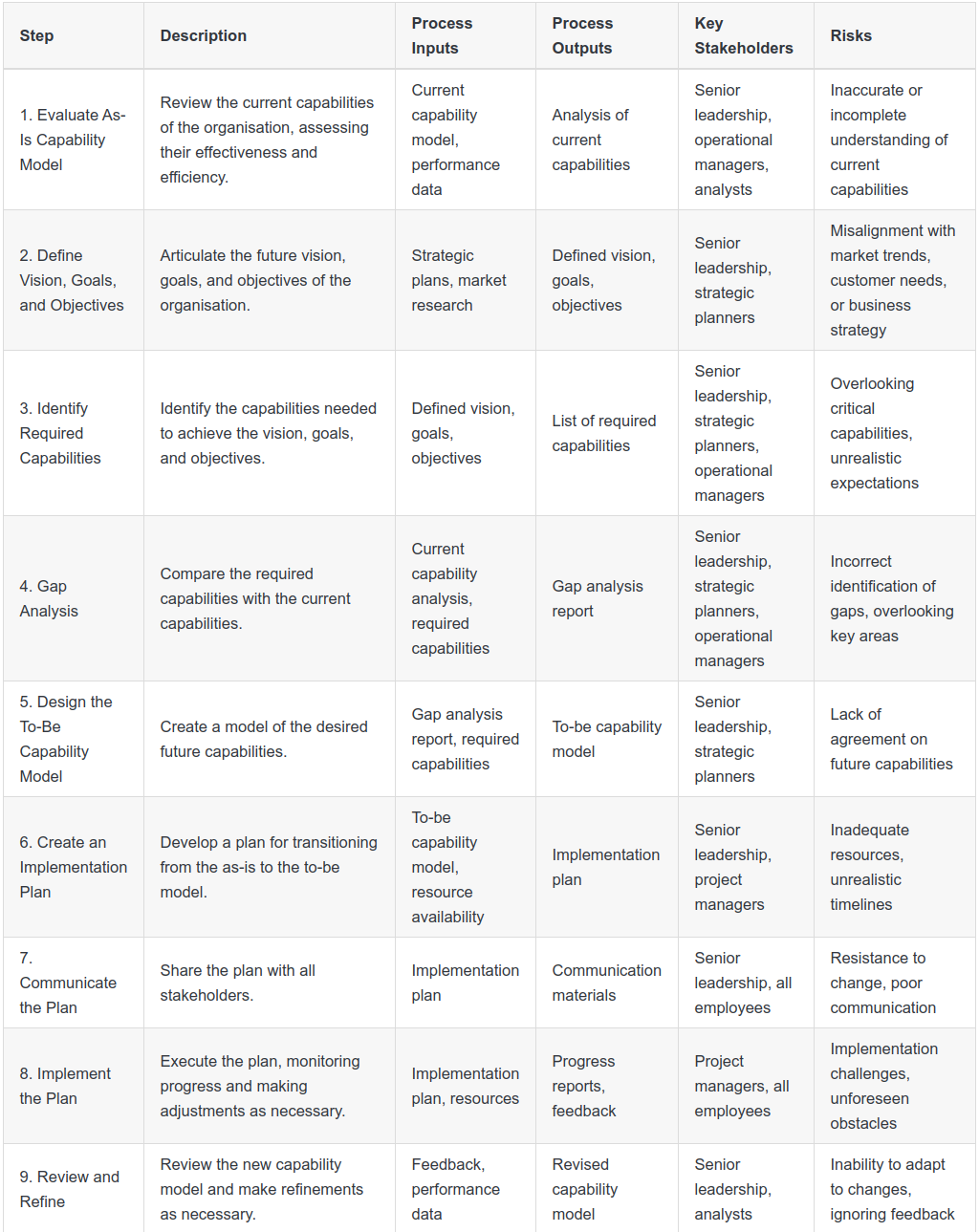
This table summarises the structured approach to capability model transformation, outlining the steps, inputs, outputs, stakeholders, and potential risks at each stage. However, remember that the process is iterative and may need to be adjusted based on the specific context and needs of your organisation. Implementation is not a one-time process, but an ongoing cycle of evaluation, planning, implementation, and review. As the organisation's vision, goals, and objectives evolve, so too should its capabilities.
To Conclude
In this exploration of Capability Modelling, we have taken an enlightening journey, from capturing an as-is capability model to designing a future-focused to-be model. Across various organisational contexts - be it military, public sector, or "critical national infrastructure" organisations - we've seen how crucial it is to understand our current capabilities, assess their efficacy, and align our future capabilities with our strategic objectives. This iterative process is not a one-off event, but a cycle that ensures we continuously adapt and evolve in response to an ever-changing environment. As part of your Operating Model (re)Design programne, capability modelling can drive strategic transformation and ensure that organisations are well-equipped to face the challenges of tomorrow.
And remember: every change begins with understanding where we stand today.
References
There are many useful publications and materials on this subject. We include a number below, some of which we have referenced and used to provide examples and conclusions. We encourage you to explore this material as it can help set context or provide additional information. All rights reserved, All Trademarks Acknowledged, and all original content referenced is owned by the third parties identified.
Capability Modelling:
- Rouse, W. B. (2005). A Theory of Enterprise Transformation. Systems Engineering, 8(4), 279–295.
- Williams, T., & Samset, K. (2010). Issues in Front-End Decision Making on Projects. Project Management Journal, 41(2), 38–49.
Operating Model Design:
- Campbell, A., Gutierrez, M., & Lancelott, M. (2017). Operating Model Canvas. Van Haren Publishing.
- Mocker, M., Ross, J. W., & Fonstad, N. O. (2014). Building Your Company's Capabilities Through Global IT Architecture. MIT Sloan Management Review, 55(3), 1-7.
Change Management:
- Kotter, J. P. (1996). Leading Change. Harvard Business School Press.
- Hiatt, J. (2006). ADKAR: a model for change in business, government, and our community. Prosci.
Public Sector & Military Transformation:
- Rainey, H. G. (2014). Understanding and Managing Public Organisations. Jossey-Bass.
- Alberts, D. S., & Hayes, R. E. (2007). Planning for Planners: A Practical Guide for Defense Planners. CCRP Publication Series.
Critical Infrastructure Protection:
- Lewis, T. G. (2006). Critical Infrastructure Protection in Homeland Security: Defending a Networked Nation. Wiley-Interscience.
Strategic Alignment and Gap Analysis:
- Kaplan, R. S., & Norton, D. P. (2006). Alignment: Using the Balanced Scorecard to Create Corporate Synergies. Harvard Business Review Press.
- Rouse, W. B. (2005). A Theory of Enterprise Transformation. Systems Engineering, 8(4), 279–295. Please note that some of these resources might require purchase or access through specific educational or professional institutions.

